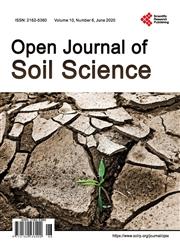Effect of Land Use Management Patterns on Mineralization Kinetics of Soil Organic Carbon in Mount Bambouto Caldera Area of Cameroon
引用次数: 4
Abstract
Soil organic carbon (SOC) mineralization was carried out on soil samples collected from two depths: 0 - 20 cm and 20 - 40 cm for all land use (LU) types (grasslands, croplands, natural forest/fallow lands, cocoa/palm plantations, and settlement/agro-forests). Microbiological analyses were carried out by measuring microbial activity in 40 g of dried soil samples wetted to 60% water holding capacity and incubated at 27 °C. Carbon dioxide (CO2) emission was measured for 10 weeks using a CO2 trap. Descriptive and graphical analyses of CO2 respiration were done using CO2 emission data. Models were developed to describe CO2 respiration and the first order kinetic model provided best fit to C-mineralization. Potentially mineralizable carbon (Co) and C-mineralization rate were higher in grasslands than other LU types, indicating a higher rate of microbial activity and carbon cycling. Metabolic quotient was higher in forest/fallow lands and reflects greater stress of the microbial community and a high requirement of maintenance energy. Grasslands enhanced more SOC accumulation and decomposition, suggesting a better carbon sink than other land use and management systems (LUMS). Microbial biomass carbon (MBC) and microbial biomass nitrogen (MBN) varied across LU patterns with maximum values in grasslands and minimum values in natural forest/fallow lands insinuating better soil quality for grasslands. MBC and SOC positively correlated with Co and C-mineralization, which intimates that C-mineralization is influenced by availability of MBC and SOC. Metabolic quotient (qCO2) negatively correlated with microbial quotient (MBC:SOC), depicting that higher values of qCO2 signify difficulties in using organic substrates during microbial activity as a result of low MBC:SOC. Changes in LUMS affected the mineralization kinetics of SOC in the study area.喀麦隆Bambouto火山口地区土地利用管理模式对土壤有机碳矿化动力学的影响
对所有土地利用类型(草地、农田、天然林/休耕地、可可/棕榈种植园和聚落/农林业)在0 ~ 20 cm和20 ~ 40 cm两个深度采集的土壤样品进行了土壤有机碳矿化。微生物学分析是通过测量40 g干燥土壤样品的微生物活性来进行的,这些土壤样品湿润到60%的持水量,并在27°C下孵育。使用二氧化碳捕集器测量了10周的二氧化碳(CO2)排放量。利用CO2排放数据对CO2呼吸进行描述性和图形化分析。建立了描述CO2呼吸作用的模型,其中一级动力学模型最适合c矿化。潜在矿化碳(Co)和碳矿化率均高于其他类型的草地,表明微生物活动和碳循环速率较高。森林/休耕地的代谢商较高,反映了微生物群落的应激和维持能量的高需求。草地促进了土壤有机碳的积累和分解,表明草地具有较好的碳汇功能。微生物生物量碳(MBC)和微生物生物量氮(MBN)在不同土壤类型中存在差异,草地最高,天然林/休耕地最低,表明草地土壤质量较好。MBC和SOC与Co和c矿化呈正相关,表明c矿化受MBC和SOC有效性的影响。代谢商(qCO2)与微生物商(MBC:SOC)负相关,说明较高的qCO2值意味着微生物活动期间由于MBC:SOC低而难以利用有机基质。LUMS的变化影响了研究区有机碳的矿化动力学。
本文章由计算机程序翻译,如有差异,请以英文原文为准。
求助全文
约1分钟内获得全文
求助全文

 求助内容:
求助内容: 应助结果提醒方式:
应助结果提醒方式:


